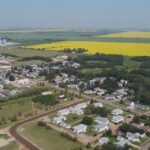In a rare celestial spectacle, Canadians from coast to coast may witness one of the most impressive aurora borealis displays of 2025 tonight. A powerful G3-class geomagnetic storm, triggered by a massive coronal mass ejection that left the sun on Saturday, is expected to create ideal conditions for viewing the Northern Lights across most of Canadian territories.
“This particular solar event is unusually intense for early summer,” explains Dr. Sarah Mitchell, senior astrophysicist at the Canadian Space Weather Forecast Centre. “The solar particles are expected to reach Earth’s atmosphere around 9 p.m. Eastern Time, potentially creating vibrant curtains of green, purple, and even rare red aurora visible much further south than normal.”
The geomagnetic storm, rated 7 out of 9 on the Kp-index (a scale measuring aurora strength), has prompted Environment Canada to issue a special aurora watch for tonight. Residents as far south as Toronto, Montreal, and even parts of the northern United States may catch glimpses of the dancing lights, weather permitting.
For optimal viewing, experts recommend finding locations away from city light pollution. “Rural areas at least 30 kilometers from major urban centers will offer the best experience,” advises amateur astronomer James Peterson, who maintains the popular Canadian Aurora Watch website. “The show typically begins after sunset and can continue into the early morning hours, with peak activity expected between 11 p.m. and 2 a.m. local time.”
The phenomenon occurs when charged particles from the sun interact with Earth’s magnetic field and atmospheric gases, creating the characteristic glowing displays. While the Northern Lights are frequently visible in northern territories like Yukon and Northwest Territories, events of this magnitude reaching southern Canada happen only a few times annually.
Weather forecasts suggest clear skies across much of central and western Canada tonight, with some cloud cover potentially limiting visibility in Atlantic provinces. Photography enthusiasts are preparing for the event, with camera clubs across the country organizing last-minute excursions to capture the rare display.
“You’ll want a camera capable of long exposure settings, a sturdy tripod, and patience,” recommends professional photographer Elena Kim. “Even if the naked eye can only detect faint glows, cameras can often capture more vibrant colors than we can see.”
The Canadian Space Agency has also launched a citizen science initiative, encouraging Canadians to report aurora sightings through their mobile application, contributing valuable data to ongoing research on solar-terrestrial interactions.
This spectacular light show coincides with Canada’s growing interest in space tourism and astronomical events. Several northern communities have developed aurora-viewing infrastructure in recent years, bolstering local economies through specialized tourism opportunities that showcase Canada’s unique geographical position for observing these natural wonders.
As Canadians prepare for tonight’s celestial display, many wonder: could this remarkable aurora event signal the beginning of more frequent and intense Northern Lights as we approach the solar maximum period predicted for late 2025? Only time—and the night sky—will tell.

























